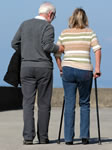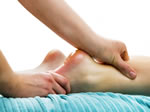Do you Suffer with Joint Pain?
Arthritis is characterised by inflammation and degeneration of a joint, which causes joint pain and swelling. Arthritis most commonly affects the hands, back, knees and hips. It can progress to the point where it affects work, sports and everyday life activities.
How can you get Relief from Joint Pain?

Knowledge of Arthritis is developing rapidly and modern treatments are improving the quality of life of people with Arthritis. There is always something that can be done to help Arthritis and, by understanding more about Arthritis, people are better able to help themselves.
Having Arthritis doesn’t have to mean that sports, work and everyday activities get progressively more difficult, in fact under the supervision of your doctor and Chartered Physiotherapist a sensible level of exercise can reduce the symptoms of Arthritis.
What can you do?
Consult your Doctor
Early treatment may be able to slow the progression of Arthritis. Painful flare ups can be treated with Anti-Inflammatory Medication prescribed by a doctor. For those people who prefer not to take tablets Anti-Inflammatory Gel can be effective in relieving joint pains. Anti-Inflammatory Gel works directly at the site of pain and can also be used with Anti-Inflammatory Medication prescribed by your doctor.

Exercise & Stay Active
Exercise and maintain an active lifestyle following advice from a Chartered Physiotherapist. By maintaining muscle function the joints are better protected and movement helps to prevent joint stiffness. Running in water with the aid of a Bouyancy Belt can be very effective in the management of Arthritis and Rheumatism.
Apply Hot & Cold Therapy
Hot and Cold Therapy can be very helpful for direct symptom relief. Ice packs can be applied for 20 minutes every couple of hours.
There are various methods of applying hot & cold therapy:
- Instant Hot Packs & Instant Cold Packs
 Instant Hot Packs & Instant Cold Packs don’t require any heating or freezing, so they can be easily transported and stored. A chemical reaction causes them to be become instantly hot or cold. They are ideal for instant pain relief when you’re on the move.
Instant Hot Packs & Instant Cold Packs don’t require any heating or freezing, so they can be easily transported and stored. A chemical reaction causes them to be become instantly hot or cold. They are ideal for instant pain relief when you’re on the move. - Ice Bags
 A reusable, fabric Ice Bag can be filled with ice cubes, crushed ice or ice water, for the safe application of ice therapy without skin burn. They can also be filled with hot water (not boiling) for applying heat.
A reusable, fabric Ice Bag can be filled with ice cubes, crushed ice or ice water, for the safe application of ice therapy without skin burn. They can also be filled with hot water (not boiling) for applying heat. - Reusable Hot/Cold Packs
 Reusable Cold/Hot Packs can be warmed up or frozen, and the special gel they contain then retains its temperature for around 30 minutes, making them great for home use. To avoid ice burn, the ice pack should be covered by a cloth that has been immersed in cold water.
Reusable Cold/Hot Packs can be warmed up or frozen, and the special gel they contain then retains its temperature for around 30 minutes, making them great for home use. To avoid ice burn, the ice pack should be covered by a cloth that has been immersed in cold water. - Hot/Cold Therapy Wrap
 A Cold/Hot Therapy Wrap can be used to secure hot or cold packs in place, making the therapy much more effective. For cold therapy, they also avoid the risk of ice burn without the need for wraping the cold pack in a cumbersome cloth.
A Cold/Hot Therapy Wrap can be used to secure hot or cold packs in place, making the therapy much more effective. For cold therapy, they also avoid the risk of ice burn without the need for wraping the cold pack in a cumbersome cloth. - Continuous Ice Therapy & Compression Device
 The Aircast Cryocuff is the most effective method of providing ice therapy and eliminates the risk of ice burn and peripheral nerve damage. It can provide continuous ice cold water and compression for 6 to 8 hours and significantly reduce pain and swelling.
The Aircast Cryocuff is the most effective method of providing ice therapy and eliminates the risk of ice burn and peripheral nerve damage. It can provide continuous ice cold water and compression for 6 to 8 hours and significantly reduce pain and swelling.
It is the ultimate ice therapy home treatment and the professional’s choice for the foot, ankle, knee, shoulder, wrist and hand.
Dangers to be aware of:
- Never apply ice directly to the skin as it can cause an ice burn.
- Ice should not be applied to the following vulnerable areas, as it can cause damage to peripheral nerve tissue:
- the neck
- the upper part of the collar bone
- the bony aspects of the elbow
- the front of the hip region
- the outer side of the knee
- Ice therapy should not be applied to the kidney region, under the back of the ribs.
The use of ice therapy should ideally be under the direction of a Chartered Physiotherapist and should be avoided where patients have extreme reactions to cold, have high blood pressure, impaired sensation or circulatory problems.

Avoid putting on Excessive Weight
Obesity increases stress on the joints and accelerates the progression of Arthritis. Excessive fat and sugar in the diet can cause obesity and increase inflammation in affected joints. A balanced diet with plenty of fruit and vegetables is recommended.
Take Dietary Antioxidants
Some research suggests that increased intake of dietary antioxidants, such as vitamins C and E, might protect against Arthritis by improving the quality of joint cartilage.
Massage
 Massage therapy can be effective in relieving the symptoms of Arthritis. Massage increases blood flow, mobilises soft tissue and improves lymphatic drainage. This helps to bring nutrients to the soft tissues, break down adhesions that cause stiffness and remove waste products. Professional massage therapy can be extremely effective, but if this is not available self or partner massage can also relieve symptoms.
Massage therapy can be effective in relieving the symptoms of Arthritis. Massage increases blood flow, mobilises soft tissue and improves lymphatic drainage. This helps to bring nutrients to the soft tissues, break down adhesions that cause stiffness and remove waste products. Professional massage therapy can be extremely effective, but if this is not available self or partner massage can also relieve symptoms.
Massage using Massage Oils & Gels can provide muscle relaxation and therapeutic pain relief. Dr Warrier’s Pain Relieving Massage Oil contains a combination of herbs well known for their anti-inflammatory and pain relieving properties. Massage facilitates its absorption into the musculoskeletal system where it works to relieve pain and promote healing. Deep Relief Gel with Ibuprofen is a clear, non-sticky and non-greasy gel with a mild, pleasant menthol fragrance and is also effective in the relief of pain in mild Arthritis.
Massage Balls can be used to provide extra therapeutic stimulation and assist with self massage.



 Instant Hot Packs & Instant Cold Packs don’t require any heating or freezing, so they can be easily transported and stored. A chemical reaction causes them to be become instantly hot or cold. They are ideal for instant pain relief when you’re on the move.
Instant Hot Packs & Instant Cold Packs don’t require any heating or freezing, so they can be easily transported and stored. A chemical reaction causes them to be become instantly hot or cold. They are ideal for instant pain relief when you’re on the move. A reusable, fabric Ice Bag can be filled with ice cubes, crushed ice or ice water, for the safe application of ice therapy without skin burn. They can also be filled with hot water (not boiling) for applying heat.
A reusable, fabric Ice Bag can be filled with ice cubes, crushed ice or ice water, for the safe application of ice therapy without skin burn. They can also be filled with hot water (not boiling) for applying heat. Reusable Cold/Hot Packs can be warmed up or frozen, and the special gel they contain then retains its temperature for around 30 minutes, making them great for home use. To avoid ice burn, the ice pack should be covered by a cloth that has been immersed in cold water.
Reusable Cold/Hot Packs can be warmed up or frozen, and the special gel they contain then retains its temperature for around 30 minutes, making them great for home use. To avoid ice burn, the ice pack should be covered by a cloth that has been immersed in cold water. A Cold/Hot Therapy Wrap can be used to secure hot or cold packs in place, making the therapy much more effective. For cold therapy, they also avoid the risk of ice burn without the need for wraping the cold pack in a cumbersome cloth.
A Cold/Hot Therapy Wrap can be used to secure hot or cold packs in place, making the therapy much more effective. For cold therapy, they also avoid the risk of ice burn without the need for wraping the cold pack in a cumbersome cloth. The Aircast Cryocuff is the most effective method of providing ice therapy and eliminates the risk of ice burn and peripheral nerve damage. It can provide continuous ice cold water and compression for 6 to 8 hours and significantly reduce pain and swelling.
The Aircast Cryocuff is the most effective method of providing ice therapy and eliminates the risk of ice burn and peripheral nerve damage. It can provide continuous ice cold water and compression for 6 to 8 hours and significantly reduce pain and swelling.